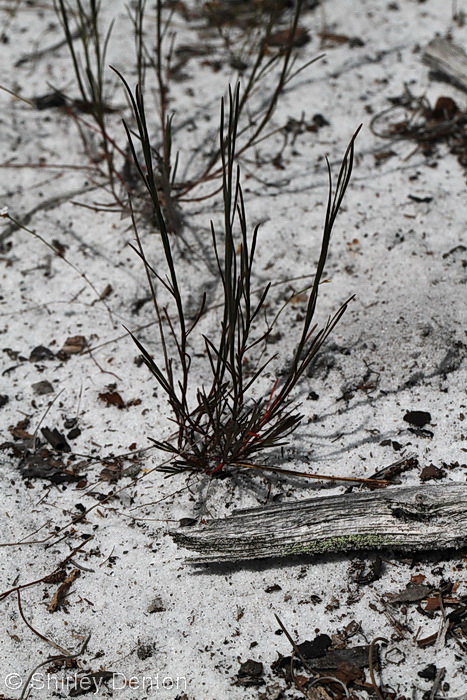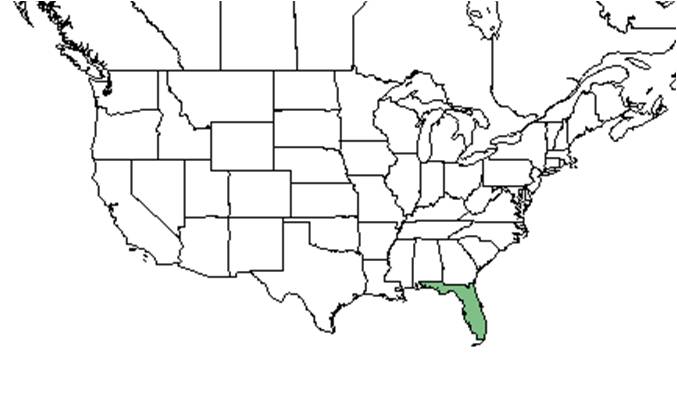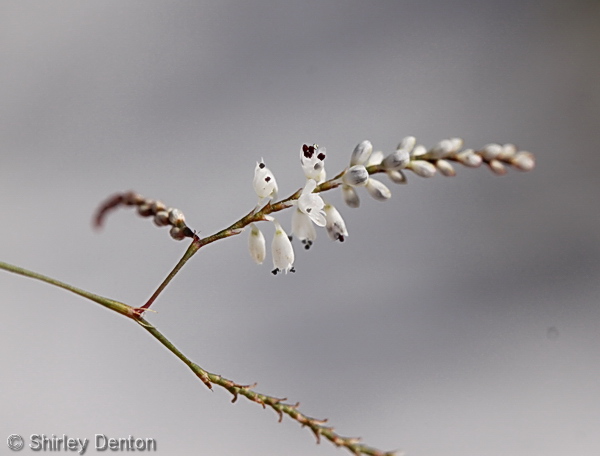Difference between revisions of "Polygonella basiramia"
KatieMccoy (talk | contribs) |
KatieMccoy (talk | contribs) |
||
| Line 34: | Line 34: | ||
===Phenology=== <!--Timing off flowering, fruiting, seed dispersal, and environmental triggers. Cite PanFlora website if appropriate: http://www.gilnelson.com/PanFlora/ --> | ===Phenology=== <!--Timing off flowering, fruiting, seed dispersal, and environmental triggers. Cite PanFlora website if appropriate: http://www.gilnelson.com/PanFlora/ --> | ||
| − | Flowers in November (FSU Herbarium). | + | Flowers in November (FSU Herbarium). This is a gynodioecious species with perfect and pistillate flowers on different individuals. The perfect individuals have blue-black anthers<ref name="archbold"/>. It is a short-lived polycarpic perennial (Boyle et al. 2003). |
===Seed dispersal=== | ===Seed dispersal=== | ||
Revision as of 14:35, 23 February 2016
| Polygonella basiramia | |
|---|---|

| |
| Photo by Shirley Denton (Copyrighted, use by photographer’s permission only), Nature Photography by Shirley Denton | |
| Scientific classification | |
| Kingdom: | Plantae |
| Division: | Magnoliophyta - Flowering plants |
| Class: | Magnoliopsida – Dicotyledons |
| Order: | Caryophyllales |
| Family: | Polygonaceae |
| Genus: | Polygonella |
| Species: | P. basiramia |
| Binomial name | |
| Polygonella basiramia (Small) G.L. Nesom & V.M. Bates | |

| |
| Natural range of Polygonella basiramia from USDA NRCS Plants Database. | |
Common name: Florida jointweed, wireweed
Contents
Taxonomic notes
Description
A description of Polygonella basiramia is provided in The Flora of North America.
Distribution
It is endemic to the rosemary scrubs in Florida's Polk and Highlands counties[1].
Ecology
Habitat
P. basiramia is limited to the xeric white and gray sands found along the Lake Wales, Winter Haven, and Bombing Range Ridges[1]. It it found primarily in gaps and disturbed roadsides of rosemary balds[2]. It is sensitive to the encroachment of shrubs and ground lichens due to increased competition for light or water (Hawkes and Menges 1995). Presence of other species has been found to negatively affect P. basiramia densities.
Associated species include Prunus geniculata, Sanidophyllum, and Paronychia pulvinata (FSU Herbarium).
Phenology
Flowers in November (FSU Herbarium). This is a gynodioecious species with perfect and pistillate flowers on different individuals. The perfect individuals have blue-black anthers[2]. It is a short-lived polycarpic perennial (Boyle et al. 2003).
Seed dispersal
Seed bank and germination
Fire ecology
Pollination
The following Hymenoptera families and species were observed visiting flowers of Polygonella basiramia at Archbold Biological Station (Deyrup 2015):
Colletidae: Colletes mandibularis
Halictidae: Agapostemon splendens, Augochlorella gratiosa, Augochloropsis anonyma, Lasioglossum miniatulus, L. nymphalis
Megachilidae: Megachile brevis pseudobrevis
Sphecidae: Anacrabro ocellatus, Philanthus politus, Tachysphex similis
Vespidae: Stenodynerus histrionalis rufustus
Use by animals
Diseases and parasites
Conservation and Management
Cultivation and restoration
Photo Gallery
Flowers of Polygonella basiramia Photo by Shirley Denton (Copyrighted, use by photographer’s permission only), Nature Photography by Shirley Denton
References and notes
Deyrup, M.A. and N.D. 2015. Database of observations of Hymenoptera visitations to flowers of plants on Archbold Biological Station, Florida, USA.
Florida State University Robert K. Godfrey Herbarium database. URL: http://herbarium.bio.fsu.edu. Last accessed: November 2015. Collectors: James D. Ray. States and Counties: Florida: Highlands. Compiled by Tall Timbers Research Station and Land Conservancy.
